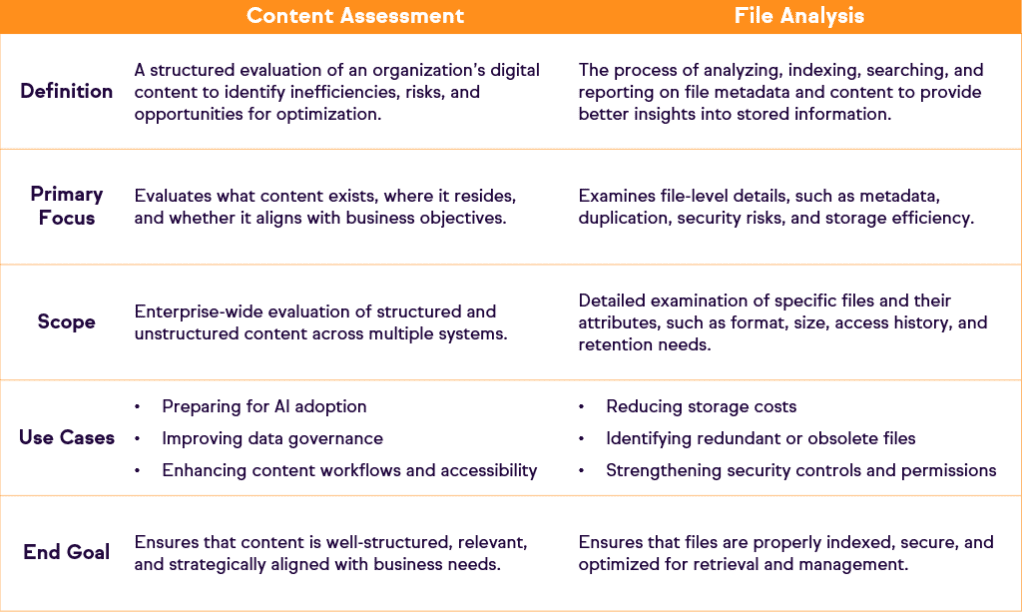Every day, businesses generate vast amounts of digital content—documents, emails, reports, and records—spanning multiple platforms, databases, and cloud systems. Yet, this data can quickly become a liability without a structured approach. Studies show that 47% of employees struggle to locate the information they need to perform their jobs effectively. Unmanaged content leads to inefficiencies, compliance risks, and poor decision-making.
At the same time, organizations are increasingly exploring automation and artificial intelligence (AI) to drive insights, which require clean, well-structured data. However, fragmented, outdated, or disorganized content can reduce AI’s effectiveness, creating barriers to accurate analysis and seamless operations.
This is where content assessment and file analysis come into play. These processes can help businesses optimize their digital content, streamline operations, reduce risks, and unlock the full potential of their information assets. By evaluating and structuring enterprise data, organizations can enhance compliance, improve efficiency, and prepare for the use of AI and automation initiatives.
In this article, we’ll explore:
- How content assessment and file analysis work
- The risks of unmanaged content and data degradation
- How structured, high-quality data drives better decision-making and AI adoption
- Key components of a successful content assessment strategy
By taking a proactive approach, organizations can transform their content into a strategic advantage, boosting efficiency, strengthening compliance, and setting the stage for data-driven innovation.
Content assessment vs. file analysis: Understanding the difference
While content assessment and file analysis are often used together to optimize enterprise data, they serve distinct purposes.

How they work together
While content assessment provides a strategic view of an organization’s digital content landscape, file analysis delivers granular insights into individual files. By combining both approaches, businesses can reduce clutter, enhance compliance, and improve the overall value of their data assets.
How content assessment differs from data audits and system migrations
A data audit is a verification process that ensures information is where it should be or has successfully moved to its intended destination. Similarly, system migration validation focuses on confirming that data has been accurately transferred between platforms.
In contrast, content assessment and file analysis are performed to go beyond cataloging information. These processes evaluate data quality, accessibility, relevance, and security to provide deeper insights. By taking a strategic approach, content assessments help organizations optimize their data management practices rather than just confirming data placement.
The risk of content degradation
As organizations accumulate content across multiple platforms, data degradation becomes a serious risk. Outdated, redundant, or low-quality content can slow down processes, introduce compliance concerns, and hinder AI’s ability to deliver accurate insights.
AI models perform best when they have access to structured, high-quality, and contextually relevant data. Poor-quality content, such as duplicate files, obsolete data, or missing metadata, can lead to misinformed decisions, operational inefficiencies, and lost opportunities. Without proper content assessment and file analysis, organizations risk feeding their AI systems with incomplete, biased, or inaccurate information, reducing the overall effectiveness of automation and predictive analytics.
How data clarity supports smarter business decisions and AI adoption
A well-executed content assessment and file analysis provides teams with trusted, high-value data—content that is accurate, structured, and accessible when needed. This clarity enhances human decision-making by enabling employees to find and use relevant content efficiently while strengthening AI-driven applications by providing them with clean, organized, and meaningful data to analyze.
By proactively assessing and optimizing enterprise content, organizations can:
- Improve operational efficiency by eliminating unnecessary content and streamlining processes
- Enhance compliance by identifying and securing sensitive information
- Strengthen AI and automation initiatives by ensuring data is AI-ready
- Unlock business value by turning raw data into actionable insights that drive strategic growth
For an assessment to deliver measurable value, organizations must focus on six critical areas that shape the accessibility, security, and effectiveness of their data.
6 Key components of a content assessment
A successful approach to content assessment and file analysis involves analyzing various aspects of enterprise data to gain a complete understanding of its structure, quality, and role in business operations. Below are the six critical areas of focus:
1. Content inventory
The first step in any content assessment is creating a comprehensive inventory of all digital content. This process involves identifying content types, storage locations, and the volume of information across the organization’s platforms, including:
- Document/Content management platforms
- File shares
- Collaboration tools
- Cloud storage
- Legacy systems and applications
By mapping the content landscape, organizations can evaluate whether their data is business-critical, redundant, outdated, or irrelevant. This step helps reduce data sprawl and ensures that only valuable content is retained and optimized for future use.
2. Data quality analysis
This component evaluates the accuracy, consistency, and completeness of enterprise content.
Key actions include:
- Detecting and removing duplicate content
- Updating or archiving outdated content that no longer serves business needs
- Eliminating irrelevant or unnecessary content to create a lean, high-value dataset
By improving data quality, organizations enhance operational efficiency and provide AI models with reliable data, ensuring better insights and reducing the risk of misinformed decisions.
3. Access and security evaluation
Protecting sensitive information while maintaining data accessibility is an integral part of any content strategy. During the assessment, organizations must review:
- User permissions to ensure only authorized users have access to specific content
- Access controls that protect sensitive or regulated information
Additionally, as organizations integrate AI-powered tools, it is crucial to evaluate whether future AI applications could require content access and recommend appropriate access policies to support safe, compliant use. This helps ensure compliance with security protocols and data privacy standards. A key guideline: AI tools should never have greater permissions than the user operating them.
4. Compliance assessment
For organizations in highly regulated industries, compliance is non-negotiable. A content assessment helps ensure that content aligns with:
- Industry regulations, such as financial services and healthcare requirements
- Internal information governance policies regarding data retention, access, and privacy protection
This step should also address AI-related data privacy considerations and ethical governance, ensuring that data is organized and managed responsibly to reduce exposure to regulatory penalties.
5. Process analysis
Content is meant to move through the organization, enabling collaboration, decision-making, and business operations. By examining processes, organizations can identify:
- Bottlenecks in content movement that slow down decision-making
- Process inefficiencies that hinder content accessibility and retrieval
Improving content processes can result in faster data-driven actions and support AI-driven automation tools designed to enhance productivity and operational efficiency.
6. Metadata evaluation
Metadata is the backbone of content searchability and usability. During this step, organizations assess the quality and structure of metadata to ensure:
- Content can be found quickly and easily using internal search capabilities
- Metadata models are consistent across systems and content types, which is critical for AI applications and automation
- Metadata is not overly used, as large metadata sets can contain information that is duplicative of data in other systems
High-quality metadata lays the groundwork for advanced AI applications, should the organization choose to pursue them, such as:
- Knowledge graphs, which link related information to provide deeper insights
- Auto-tagging capabilities use AI to automatically assign metadata based on content analysis
- AI-powered content classification and discovery, which streamlines access to valuable data
Additionally, streamlined metadata that maps to a single enterprise model will improve results and efficiency in AI analysis.
By addressing these six components, organizations improve the accuracy and structure of their data and create a foundation for business growth, compliance, and innovation.
The business impact of clean, relevant data
Data is one of an organization’s most valuable assets, but its value is only realized when it is accurate, organized, and accessible. A well-structured content assessment and file analysis makes sure that organizations can fully leverage their data, leading to the following benefits:
Efficiency gains
Employees can waste countless hours searching for files in poorly organized systems. Clean, well-structured data reduces this friction, allowing teams to access the right information quickly and spend more time on high-value tasks rather than sorting through clutter.
Cost savings
Outdated and redundant content inflates storage costs and slows down systems, creating inefficiencies that can add up over time. By removing expired or unnecessary data and streamlining workflows, organizations can reduce operational expenses while improving overall system performance.
Stronger compliance and risk management
Regulatory requirements around data privacy, security, and retention continue to evolve, and organizations that fail to manage their content properly face legal and financial risks. Proactive data governance ensures that content is secure, properly classified, and compliant, reducing exposure to penalties and ensuring adherence to industry regulations.
Better decision-making
High-quality data is the foundation of an informed business strategy. When employees and leadership can trust the accuracy and relevance of their data, they can make better, data-driven decisions. Additionally, AI models require structured, high-quality data to generate meaningful insights—messy or incomplete data leads to misinformed predictions and unreliable automation.
Stronger document management strategy
Effective content assessment and file analysis lay the foundation for a well-structured document management strategy. By reducing overhead and inaccuracies in existing data sets, these processes also make content migration to a unified, standard content management platform more efficient.
“A well-executed content assessment and file analysis will transform data into a strategic asset, enabling organizations to achieve their business goals with greater precision and efficiency.” – Ahmed Falouji, Senior Vice President at Viewpointe
Turn your data into a strategic advantage with Viewpointe
Organizations that proactively assess, organize, and optimize their content are better positioned to enhance efficiency, strengthen compliance, and prepare for AI-driven insights.
At Viewpointe, we help organizations develop a strategic plan for managing enterprise content through our Business Consulting Services. Leverage our expertise to explore, organize, and optimize your company’s content based on business value.
Contact us to explore how content assessment and file analysis can optimize your enterprise content and data management strategy.



